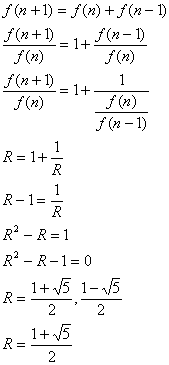
The Problem:
Generate a Fibonnaci sequence in the first column using f(0) = 1, f(1) = 1, f(n) = f(n-1) + f(n-2)
A. Construct the ratio of each pair of adjacent terms in the Fibonnaci sequence. What happens as n increases? What about the ratio of every second term? etc.
B. Explore sequences where f(0) and f(1) are some arbitrary integers other than 1. If f(0)=1 and f(1) = 3, then your sequence is a Lucas Sequence. All such sequences, however, have the same limit of the ratio of successive terms.
The Strategy:
We'll create a spreadsheet using Microsoft Excel and put the Fibonnaci numbers into the spreadsheet. Then we can simply manipulate the first two numbers in the sequence to create the Lucas sequence and others (Part B).
Exploration:
Excel Spreadsheet: click to view the spreadsheet used in this exploration.
After creating the Fibonnaci Sequence and the ratio of adjacent terms, the ratio seems to approach approximately 1.618034 as n gets large. The ratios seem to alternate around the limit of the sequence. That is, the ratios at odd values of n are less than the limit and increase to the limit. The ratios at even values of n are greater than the limit and decrease toward the limit. The ratios of the Lucas Sequence (and that of any sequence of this form, regardless of the starting integers) have the same limit and approach the limit in this same manner.
Conclusions:
It is interesting to note that 1.618034 (the limit of the ratios of the Fibonnaci numbers) is the Golden Ratio. The exact expression for this ratio is [1 + sqrt(5)] / 2. This ratio tends to occur quite a bit in the real world. For example, it can be obtained by the ratio of a person's height measured from the top of the head to the person's height measured from the navel.
To prove this result with the Fibonacci numbers, simply take the recursive formula for finding a random Fibonacci number (line 1), divide both sides by f(n) (line 2), substitute R for the ratio (line 4), multiply both sides by R (line 6), and solve the resulting equation (line 7) using the quadratic formula (line 8). Since our ratio can't be negative, the negative root is extraneous (line 9).

Since we never actually specified our starting integers, this proof would work for any starting numbers, and not just 1 and 1 (the Fibonacci starting point). So this proof works for the Lucas sequences as well as any other starting integers which would form a sequence using "Fibonacci Recursion".